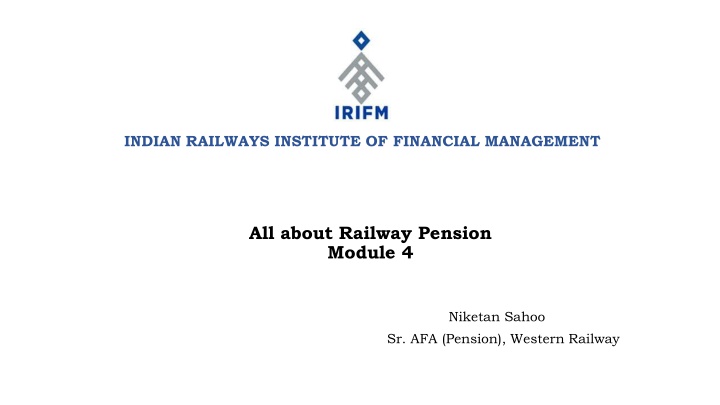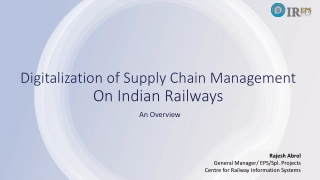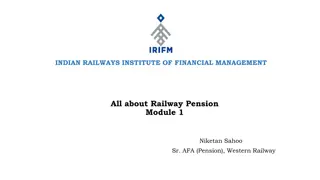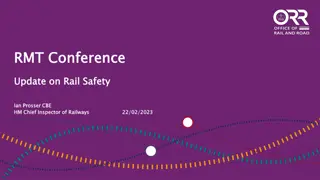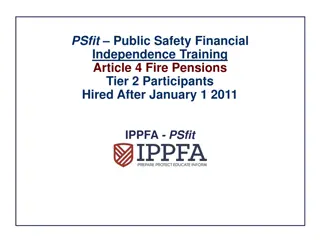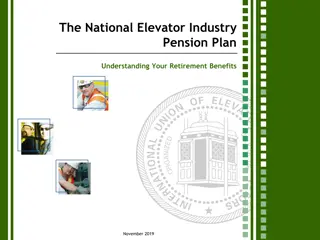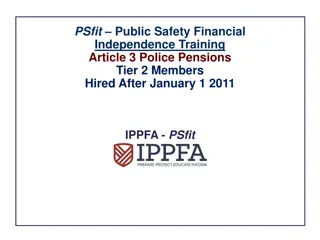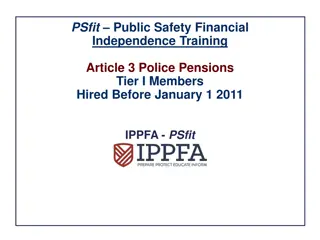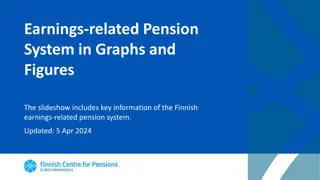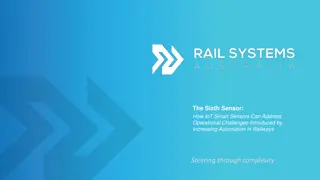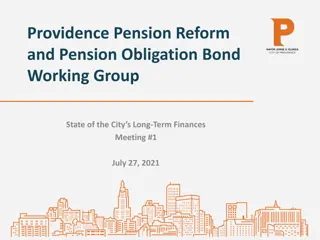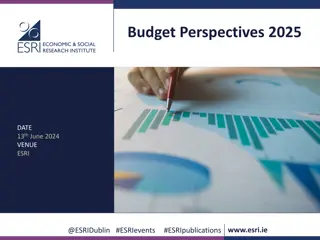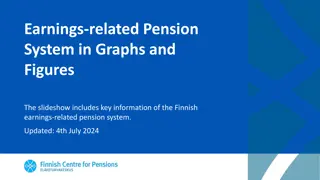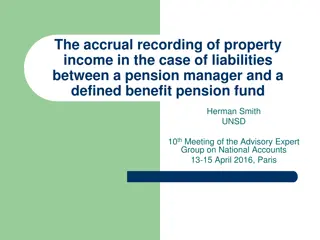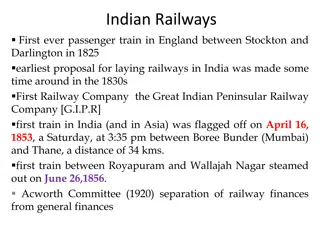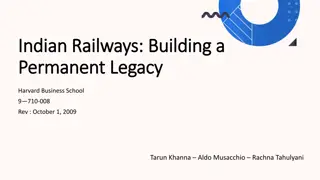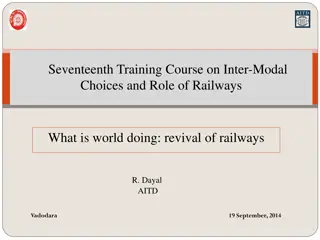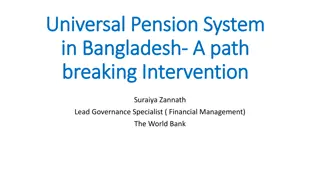Overview of Indian Railways Institute of Financial Management - Pension System
Indian Railways Institute of Financial Management (IRIFM) provides an advanced Railway Pension system through ARPAN and IPAS modules to manage pension-related activities efficiently. ARPAN offers modules for settlement, revision, reconciliation, grievance handling, and family pension, while IPAS integrates payroll data for seamless settlement and PPO processing. These systems ensure accurate pension calculations, generation of bills, digital signing of PPOs, and data sharing with relevant entities.
Download Presentation

Please find below an Image/Link to download the presentation.
The content on the website is provided AS IS for your information and personal use only. It may not be sold, licensed, or shared on other websites without obtaining consent from the author.If you encounter any issues during the download, it is possible that the publisher has removed the file from their server.
You are allowed to download the files provided on this website for personal or commercial use, subject to the condition that they are used lawfully. All files are the property of their respective owners.
The content on the website is provided AS IS for your information and personal use only. It may not be sold, licensed, or shared on other websites without obtaining consent from the author.
E N D
Presentation Transcript
INDIAN RAILWAYS INSTITUTE OF FINANCIAL MANAGEMENT All about Railway Pension Module 4 Niketan Sahoo Sr. AFA (Pension), Western Railway
Railway Pension system : its digital interfaces e-Scrolls and e- Reconciliation Virtual Retireme nt Function HRMS PPO data view [My Accounts] --ARPAN-- e-PPO e-Payment of Settlement dues NEFT/RTGS Smart Health Card [UMID/CTS E] Indian railway Pension/settlement Net Online Grievances Handling -NIVARAN- Banking [Pension A/C] Jeevan Praman On-line suggestions/ feed backs -ANUBHAV- On-line Settlement process [IPAS] 2
Advanced Railway Pension Access Network (ARPAN) ARPAN is: A web based portal for all pension related activities on a single platform. A repository for all pension related information Has interface with Railways, banks and pensioners. A single point centralised database of all IR pensioners ( Nodal Railway: WR ) A uniform and standardized application for revision, reconciliation and grievance handling. Enables instant data sharing with Railway Board, Central Government, banks, and other agencies as and when needed. Data Sharing : Integrated with IPAS,UMID,CTSE and CPPCs. The platform facilitates pensioner and users to view PPO details any time anywhere. Fetches pass book details as is integrated with e-scrolls. 3
ARPAN : Modules Settlement module : for revision of post-2016 (pre IPAS) cases as well as fresh cases of a few production units. Revision module : for revision of pre-2016 PPOs (More than 12.50 Lakh PPOs revised so far) Reconciliation module: for reconciliation of eScrolls with master data (auto fetching of mismatched records) Grievance management module : for registration, tracking, and disposal of both physical and online complaints. Re-grant family pension module : For fresh authorization of family pension to dependent family members (unmarried/widow/divorced daughters and disabled children of deceased pensioner) 4
Integrated Payroll and Accounting System (IPAS) IPAS holds detailed payroll data of IR s serving employees along with their personal and service details. Settlement Module inside IPAS pulls payroll and employee details data for settlement and PPO processing with scope for minimum data entry by module users. Settlement Module : how does it work? 1. Auto calculates all settlement and pensionary benefits, 2. Generates bills (DCRG, Commutation, Leave Encashment, GIES) with pre-assigned bank details. 3. Integrates Internal Check, Bill Passing, Books and Centralised Integrated Payment system modules. PPO Module : how does it work? 1. PPO : carries all pension related information in PDF format, used for both physical and digital PPOs. 2. ePPO : takes care of digital signing and online data pushing to concerned bank. Data pushing to ARPAN : This utility is used for updating IR s Centralised Pension database. Revision Module : Used in events of (i) difference of Settlement dues (ii) Revised PPO Data pushing to UMID portal for UMID card generation. MIS : Queries and Reports 5
E-PPO, benefits of Enables seamless data transmission to bank database through SFTP. Enables CPPCs to create readymade database without manual intervention. Facilitates faster commencement of pension by banks (ePPO is embedded with all details). Free from data tampering with enforcement of multi level security. Saves time and despatch cost, reduces human movement between HQs and Units. Saves stationery, creates carbon credit. Being a digital document, can be stored in cloud in Digi Locker. Ensures greater responsibility and accountability at unit level. Physical PPO: process Physical submissio n to HQ KYC KYC Avg. 3-4 Month s Receipt and data entry Physical despatch to bank by dak Documentatio n by pensioner verification with branch and activation verification with branch and activation e-PPO: process ZONAL HQ HQ verification DSC signed and sent to Bank BANK-CPPC Data capture & processing DIVISION/W&S e-PPO DSC SIGNED AND FORWARED TO HQ Pension Payment Max 1 Month 6
Unique Medical Identity Card (UMID) A web and mobile based application for e-validation of identity of Railway Medical beneficiaries in which: Registration, approval and card generation are done completely on the electronic platform End-to-End Solution for Medical Identity with rules integration and built-in validation Interface with Referral Hospitals plausible for authentication through Biometrics. interface with hospitals tied up under CSTE scheme Auto conversion of Employee Card to Pensioners Card on retirement. Self Service with capturing of all eligibility documents including Aadhaar & RELHS. Dispenses with manual Medical and Pensioner s Identity Cards Standardised Numbering system. Helpful for easy accessibility for availing Health facilities for employee/retiree, family. Aims at complete automation and online authentication of IR s medical beneficiaries Prevents possibility of fraudulent and bogus claims. Enables online grievance handling from registered applicants and card holders. An effective and informative portal for benefits of lakhs of pensioners about Health benefits. 7
Cashless Treatment Scheme in Emergencies (CTSE) Railway provides comprehensive medical facilities to its pensioners through its own hospitals/dispensaries. However, a pensioner may require emergency hospitalisation when away from the nearest railway hospital. To overcome this problem, CTSE was introduced. The empanelled hospital (private/semi private/Hi-Tech hospital ) shall give necessary treatment to railway pensioner and dependent family members in emergency and raise the bill directly to Railway authorities. Railway has tied up with M/S UTIITSL for implementing the scheme across zonal railways/PUs. CTSE Application virtually integrates Railways, Pensioners( smart card holders) and Empaneled Hospitals. The entire process moves on an online platform with issue of System validated CTSE smart cards. This facility is in addition to facilities covered under RELHS. A one time fee to join CTSE per family is as under: Rs.30,000/- Rs.15000 Rs.6000/- Private Ward: Semi-Private Ward: General Ward: The Scheme was initially rolled out for empaneled hospital in four metro cities (Mumbai, Delhi, Kolkata and Chennai), subsequently extended to other cities. 8
Retired Employees Liberalised Health Scheme (RELHS) 1 RELHS 97 provides the following medical facilities to a retired employee and family : Medical treatment : OPD / Hospitalization Ambulance services Home Visit Reimbursement of claims for treatment in government or recognized non railway hospitals. 2 RELHS Identity card can also be issued from the division issuing post retirement passes. 3 Eligibility Criteria to become member of RELHS: Superannuation irrespective of length of Qualifying Service. Other than superannuation cases : minimum 20 years of Qualifying Service. Death case : Family/dependents as per Pass Rules. Not open to railway servants who have resigned/been dismissed from service. 4 RELHS is interfaced with other utilities, namely, UMID, CTSE and Fixed Medical Allowance. 9
RELHS RELHS 97 subscription rates as per 7th CPC recommendations with effect from 23-02-2017: In case pensioners retired prior to 2016, the rate of subscription is double of the revised pension/family pension. Superannuated NPS employees/families of deceased NPS employees are also eligible for RELHS 97. 10
Fixed Medical Allowance (FMA) Pensioners/family pensioners residing beyond 2.5 kms from nearest Railway hospital/dispensary are eligible for this benefit. The retiring employee/pensioner needs to exercise necessary option/undertaking for FMA stating his/her place of residence, distance from hospital. The applicant must be eligible for RELHS-97 even though actual enrollment under RELHS is not required. Pensioner opting for FMA is not eligible for OPD facility from railway hospital/dispensary, except for chronic disease patients. FMA @ Rs1000 per month is paid as a separate element along with monthly pension/family pension by Pension Disbursing Agencies (banks). No Dearness Relief payable on FMA. Family Pensioner appointed on compassionate ground is not eligible for FMA, being already covered under Railway Medical Facility as an employee. Endorsement regarding eligibility for Fixed Medical Allowance is to be made in PPO. Necessary endorsement Not entitled for OPD is also to be made in RELHS Card. In case of change of Residence, Pensioner is allowed to change his/her option for FMA. 11
National Pension system (NPS) Government employees appointed on or after 01-01-2004 are covered under NPS. NPS is governed by Pension Fund Regulatory and Development Authority (PFRDA) and managed by National Securities Depository Limited (NSDL). Every NPS subscriber is issued a twelve digit unique number, Permanent Retirement Account Number (PRAN). The NPS scheme allows subscribers to contribute regularly into a pension account during their working life. The fund so invested in is subject to investment in Debt/Equity Market. Its accumulated value is called a corpus. On retirement, subscribers may withdraw a part of corpus lumpsum and use remaining corpus to buy an annuity to secure a regular income after retirement. If the subscriber dies before 60 years, the entire accumulated wealth is payable to the nominee/legal heir of the subscriber. 12
NPS : Employees monthly contribution towards the fund is @ 10% of salary with matching contribution paid by government. With effect from 1/4/2019, employer s contribution rate has been enhanced to 14%. NPS is also open to general public since 2009. Any Indian citizen aged 18 to 60 years may join NPS with contribution @ Rs500 per month and Rs.12000 per annum. The scheme offers two accounts, Tier I and Tier II. Tier I is a mandatory account, Tier II voluntary. NPS subscriber has flexibility to choose the investment option, fund manager, annuity service provider, annuity option. Tier I contribution is eligible for additional tax deduction benefit of up to Rs 50,000 under section 80CCD (1B) over and above Rs.1,50,000 under section 80C. Withdrawals are restricted and subject to terms and conditions. NPS is portable in nature and moves along with the subscriber in case of change of job or organization till the age of 60. 13
NPS : options, tiers, choices Money invested in NPS is managed by PFRDA through registered Pension Fund managers. The scheme offers two choices: Active choice : This allows the investor to decide how money should be invested in different assets, and Auto choice : This is a default option in which money is invested automatically in line with the subscriber s age profile. 14
Retirement/death/disability benefits under NPS As per directives issued by the Department of Pension and Pensioners' Welfare, benefit of retirement gratuity/death gratuity has been extended to government employees covered under NPS on same terms and conditions as are applicable under Central Civil Services (Pension) Rules, 1972. Accordingly, DCRG and Leave Encashment become payable to employee on superannuation retirement. Lump-sum payment and annuity pension under NPS are paid to employee after retirement. On superannuation at least 60% of the employee s accumulated pension corpus shall be mandatorily utilized for purchase of annuity while remaining 40% will be paid to the subscriber as a lumpsum amount. On voluntary retirement at least 80% of the employee s accumulated pension corpus shall mandatorily be utilized for purchase of annuity while remaining 20% will be paid to the subscriber as a lump sum amount. 15
Retirement/death/disability benefits under NPS contd In case of employee s death in service, benefits allowed are : 1. DCRG, 2. Leave Encashment, and 3. Family Pension. Eligible family member (nominee) needs to exercise the option: to receive lumpsum accumulated corpus from NSDL, or to receive regular Family Pension in lieu of accumulated corpus. Monthly Pension is payable by Railways directly to beneficiary account through NEFT, not through banks like in case of IR s regular pensioners. In case of employee s death, Government also allows the family the option to switch over by refunding corpus received by the beneficiary from NSDL along with interest thereon. 16
Thank You 17
